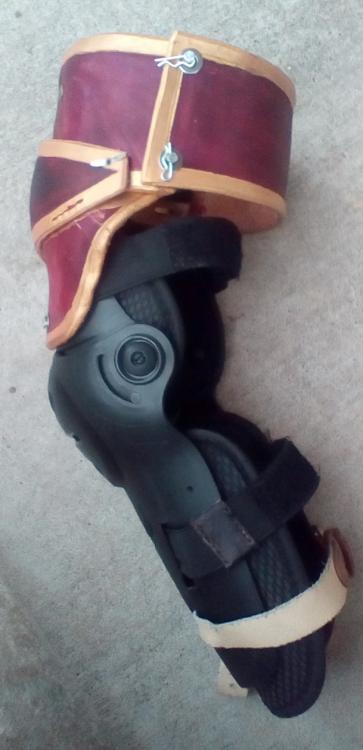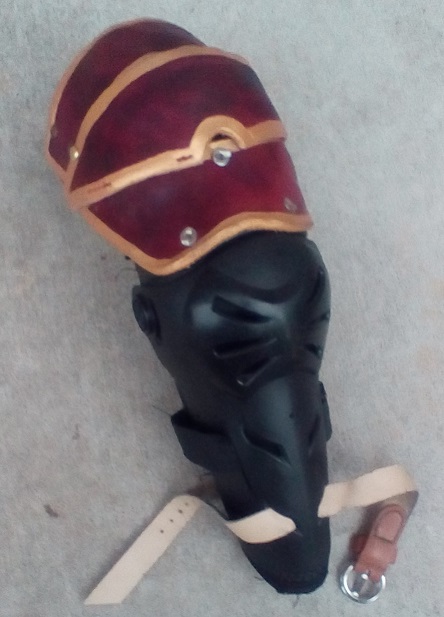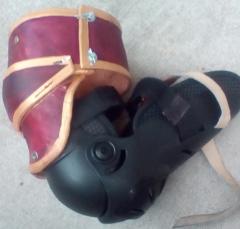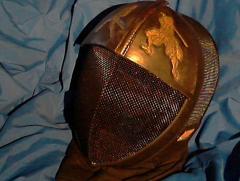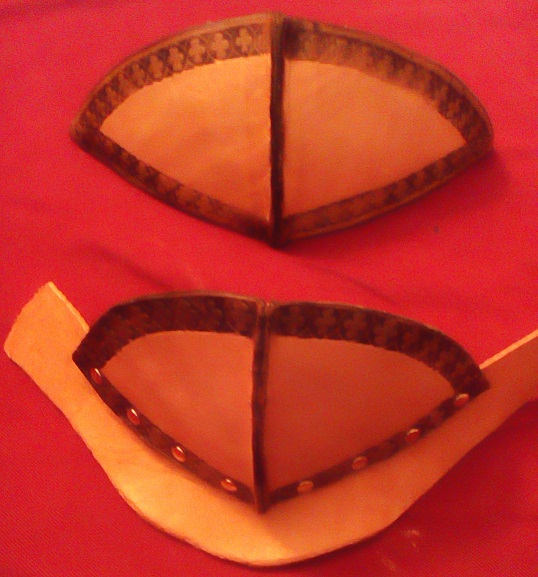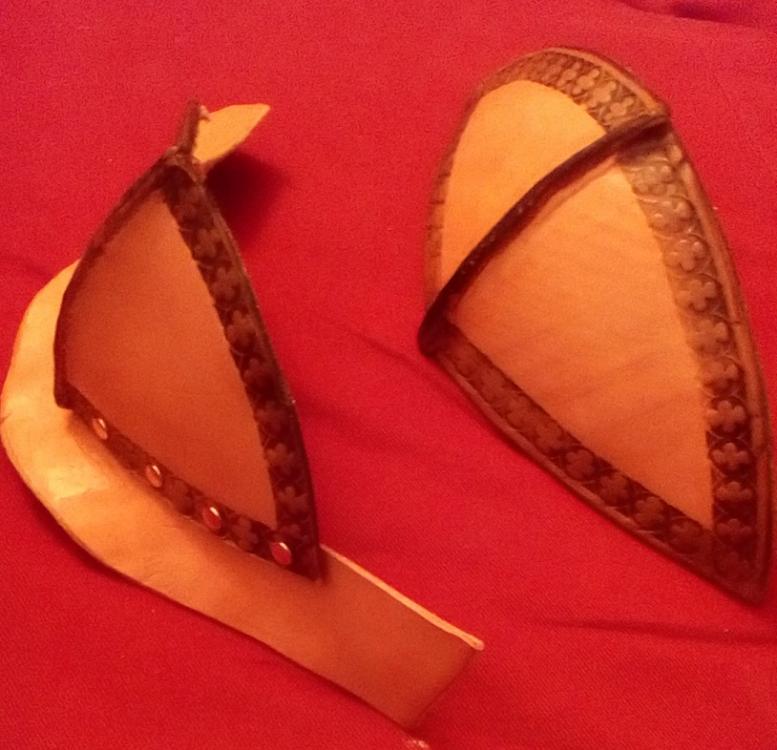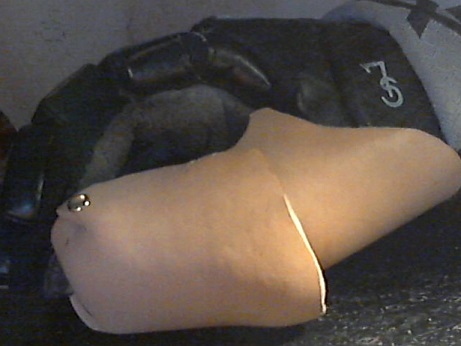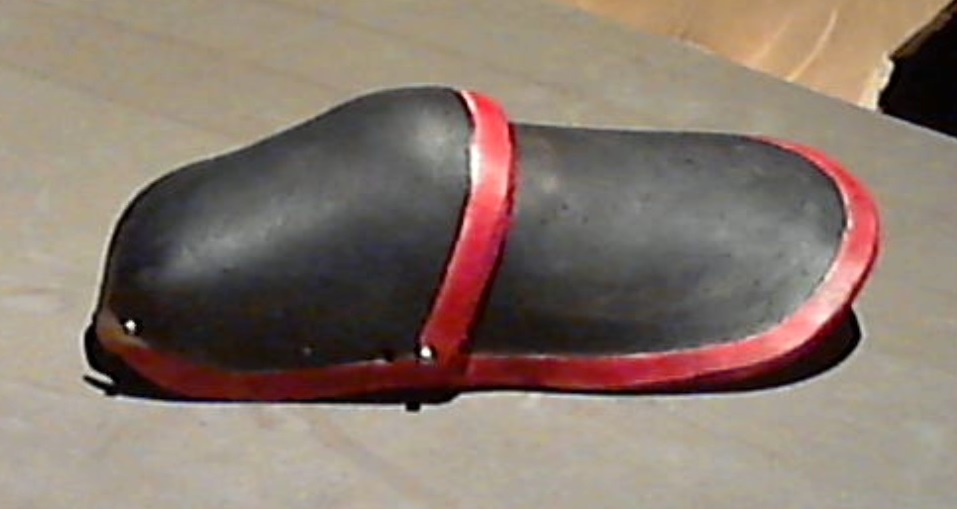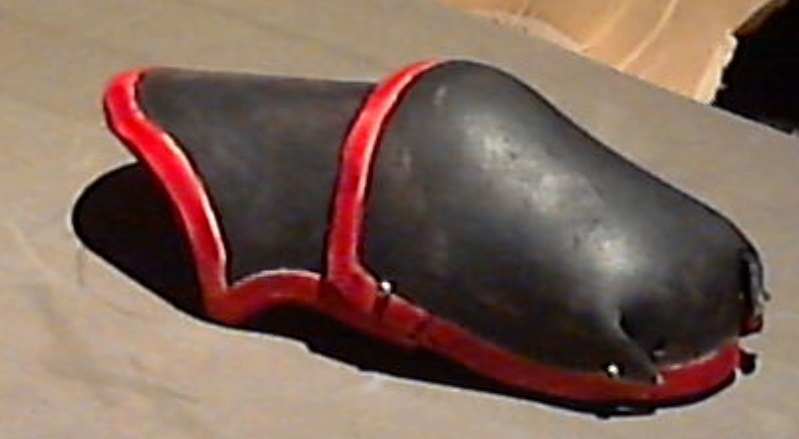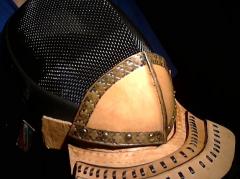Search the Community
Showing results for tags 'fencing'.
-
I've been working on augmenting my existing arm protection, which is adequate for nylon sword simulators, but I want more for steel. Plus, armor is cool! This is the whole shebang together: Leather: unknown source -- I have a variety of veg-tan leather, and these pieces are from the bellies I got last year. Dye: Angelus Burgundy, and gold Acrylic paint. The arm guard is meant for motorcyle use, but it covers all the bone points of the elbow and has a nice 90 degree articulation. But that 90 degree caused problems in this design -- originally there was just one piece riveted to the plastic plate. But I found that I need the arm to close to a more acute angle than 90 (30 or 40 degrees), so the elbow kept popping open and locking. Oops... So this is my solution-- I cut the piece in half, and added an articulating lame at the back. So now I get this: Note the lugs just under the circular pivot joint -- those are meant to only go 90 degrees, yet they can pop out under stress. The articulated lame lets the arm bend more: You can see the cracks in the cuir boulli leather -- there are just so many variables that make it a risky proposition. The surface here is rigid, but the leather underneath is not. The lame is water hardened a different way-- I got it wet, shaped it and dished it (onto the plastic here) and then let it dry in the sun. I am lot more satisfied with that method (I've used a wall heater in the winter to do the same thing). I used split rivets to fasten the lower leather piece to the plastic (easier to remove them in the future) after drilling three holes in the plastic. The rerebrace is closed using cotter pins -- eventually I may have additional holes so that I can close it tighter if I want. And inside, held on by the bronze covered rivets, is a Kydex plate (.080 thickness), heated into a nice U shape with a heat gun, adding a layer of plastic rigidity to the leather. Here's a shot of the backside: The cutout over the split rivet will make removal a lot easier. The articulating lame is sewn to the lower plate, and riveted to the upper plate. After I put the articulating rivets in, I'll test this Wednesday night and see how it goes. I may also take the heat gun to the plastic "dish" pieces and flare them out so they'll "catch" on each other, preventing any pop-open.
-
From the album: DJole -- Completed Work
I augmented the arm guards I use for longsword fencing -- now I have a functional rerebrace that covers the upper arm. The picture doesn't contain the final rivets, but the articulating lame is in the right place.-
- armor
- cuir boulli
-
(and 1 more)
Tagged with:
-
From the album: DJole -- Completed Work
Here are the two panels sewn together, with the center strip, in place on a mask. The antique black of the swordsmen really makes a nice touch here! -
Another work in progress For doing HEMA (Historical European Martial Arts), a basic fencing mask is a good start, but they're not really enough protection for using steel in tournaments. Thus, there are mask overlays on the market, which add padding and protection to your head (a good thing to do!). I decided that I could make my own custom overlay, using leather to add the rigid or semi-rigid "plating" to the mask. These are the first two pieces. (I'll add others as I complete them.) The larger one goes on the forehead, a place which sees a lot of sword strikes. It will get some foam padding underneath it later on. The smaller one goes under the chin, and it will hold an additional throat protector that goes over the mask bib. That protector bit will be riveted to the strip of leather Using a fencing mask, I made a pattern from paper to get the curves right, then cut them out of leather. The border is done with a Tandy stamp, a Christmas gift (Craftool Pro Stamp-Border D2171) from their recent sale. I sewed both pieces together using my new stitching pony (brought back from Korea). The seam is left standing up, for more reinforcement. I got them nice and wet, then molded them to the fencing mask itself, strapping them down to hold shape as they dried. I used a block-out resist for the big inside panels, and a Tandy Antique Black for the border itself. The edges were burnished with water. I may use an edge paint, but I haven't decided yet. I left the leather a natural color-- it's a nice contrast. I then riveted the strip to the chin piece, and wet-molded that to shape. I have the patterns for the throat plate, but I haven't completed that part yet. I'm really pleased with the way they look so far (and they're really nice on the mask itself-- but no pictures of that yet!) to be completed: 1) Create and attach throat plates (probably leather articulation). 2) Finish design for sides and top of mask, create the same. 3) mount all pieces so they strap tightly on. 4) add foam padding 5) make back of head panel.
-
Here's my project for today-- I am making a heavy leather over-glove to go over some lighter hockey gloves that a couple people in my longsword class use. Hockey gloves aren't the best protection, so if they take a good strike to the hand it HURTS. And if you are worrying about hurting your hand all the time, it's hard to fight well. So I offered to help protect their hands better, and they thought that was a great idea! Here's the project so far: This is the thumb, two pieces wet molded onto the hockey glove and then hardened by hot air blowing over them. (I set them next to the electric wall heater nearby -- not too close, but enough so an hour or so dries the leather). Next step: Got the articulation point in the middle, and a nice curved dish shape, too. Here's a better view of the thumb tip: It curves around the thumb tip very nicely! Details: 8 to 10 oz veg tan, cut from tooling belly (I got them for a great sale price, so I don't feel bad about having to throw away a prototype that doesn't work). Dyes are Fiebing USMC black and Fiebing red. This is the right thumb -- the left thumb is drying off to my left a ways. Next step is riveting, and then on to the fingers.
-
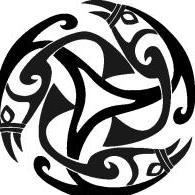
Fencing mask overlay (chin with throat plate)
DJole posted a gallery image in Gallery- Our Leatherwork
From the album: Works in Progress
The bottom plates are cuir boulli, stacked up and laced together.© Douglas Jole -- 2018


